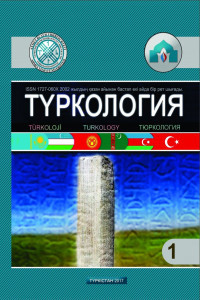NATURE AND CONTENT OF AUTHOR ORAL POETRY OF THE TURKIC PEOPLES
As a unique phenomenon in art literature, author orally poetry took place in the cultural history of many nations of the world. The masters of poetic words composed his works, in orally poetry usually by improvisation to the public and expressed their personal opinion and ethical evaluation of reality. Orally professional creativity were developed widely among the Turkic people (azans of ancient Turks, Azeris’s ashigs; Nogai’s redai; olonkhosut of Yakuts; ashik, bakhshi, shair, manasse of, Uzbeks, Turkmens and kirghiz; olonkhosut Yakuts, Bucks, yirau, akin, and sesen of Kazakhs and Bashkir et al.). The Author’s orally poetry combined artistic creativity with a great social activity. They werewsed the of le unquestioned authority by people among the masses, they were interfered in the activities of chiefs and leaders, they were influenced them by wise advices,
I they were a great connoisseur of folk epic narratives, significant historical events, genealogies ob dignitaries and, accordingly, they were used it in their performances and improvisations. The characteristic feature of creativity orally writers is to affect the most pressing problems of that relevant to the society at the time when was there a public statement to the people.
Keywords:
Improvisation, Iyrau, Bucks, Sesen Orally poetry,
___
- 1. Валиханов Ч. Избранные произведения /Вступительная статья А. Х. Маргулана. – М.: Наука,1986. – 414 с.
- 2. Гумилев Л.Н. Древние тюрки. – М.: Клишников- Комаров и К, 1993. – 528 с.
- 3. Жирмунский В. В. Тюркский героический эпос. -- Л.: Наука, Ленингр. отд., 1974–728 с.
- 4. История Всемирной литератруры: в девяти томах. Т. 2. -- М.: Наука, 1984. – 672 с.
- 5. История Всемирной литературы: в девяти томах. Т. 5. -- М.: Наука, 1988. –784 с.
- 6. Книга моего деда Коркута: Огузский героический эпос /Перевод В. В. Бартольда. – М.-Л.: Изд АН СССР, 1962. – 300 с.
- 7. Малов С.Е. Памятники древнетюркской письменности. – М. – Л.: Изд. АН СССР, 1951 – 451 с.
- 8. Мамбетов К. Пути формирования древней каракалпакской литературы. – Нукус: Каракалпакстан, 1976. – 202 с.
- 9. Махмуд ал-Кашгари. Диван луга тат-турк /Перевод, предисловие и комментарии З.-А.- М. Ауэзовой. – Алматы: Дайк-Пресс, 2005. – 1288 с.
- 10. Радлов В. В. Опыт словаря тюркских наречий. Т .3, ч. 3. – Спб., 1905. – 1260 с.
- ISSN: 1727-060X
- Başlangıç: 2002
- Yayıncı: Hoca Ahmet Yesevi Uluslararası Türk-Kazak Üniversitesi
